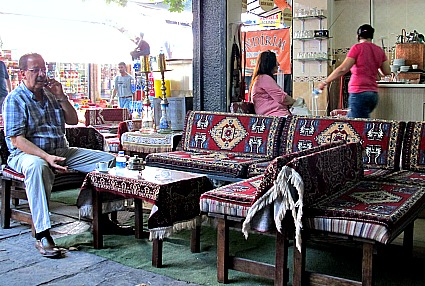Turkish tea is spelled çay and pronounced “chai,” but it isn’t the chai you find in Indian restaurants. The word simply means “tea”.
Tea is a way of life in Turkey. Everyone drinks it, and everyone offers it at all times of the day as a sign of hospitality and friendship, to seal a deal, or just because. It’s the national drink, more popular than coffee.
It is almost always made in a samovar, a double kettle with boiling water in the bottom and steeping lea leaves in the top. The tea comes out piping hot and served to you in small tulip-shaped glasses that you must grip at the top with your fingers to keep from burning them. In between sips, the glasses rest in small curved saucers. Don’t forget to drop in two cubes of sugar, which you stir with a miniature metal spoon.
Because everyone drinks tea at all hours of the day and night, one of the most ubiquitous sights in Turkey is the çayci, or tea waiter, who delivers tea to his patrons. Carrying a circular metal tray with a round handle, balancing several tulip glasses full of tea, he darts in and out of people, never spilling a drop. He brings tea to shop owners trying to schmooze a carpet sale, or who simply need a break.
Over the next two weeks, I tried to photograph these fast tea-toting fellows, but they were always long gone before I could point my camera their way.
Instead of having your tea delivered, you can simply sit down at one of the many tea shops to enjoy a glass while you people watch. I loved these carpet-covered, dwarf-sized cafés, so characteristic with their low tables, kindergarten-sized chairs, and small stools. Being 4’11’, I felt quite comfortable! (Gino, at 5’10”, maybe not so much.)












